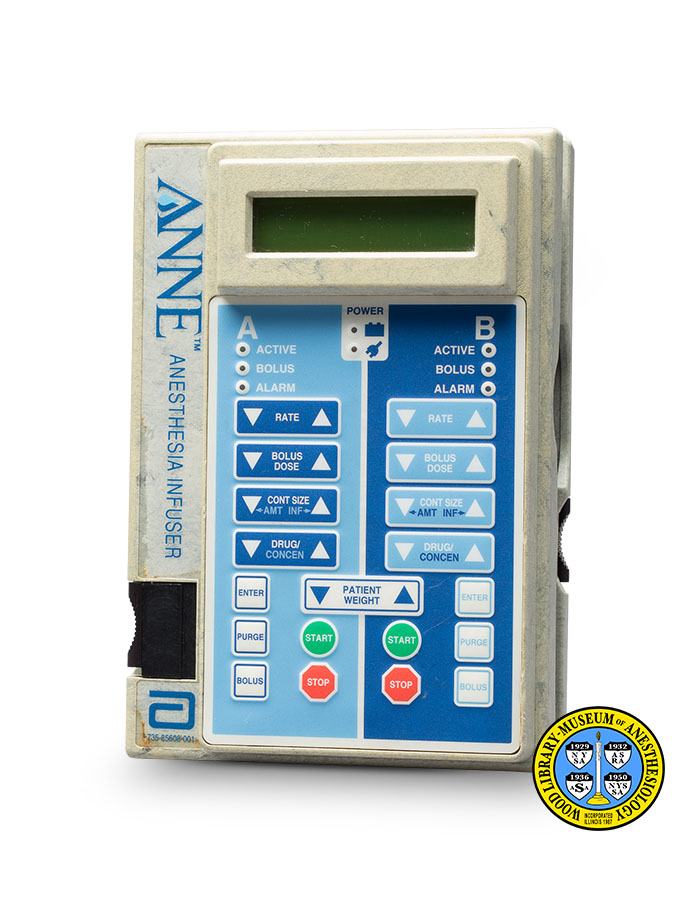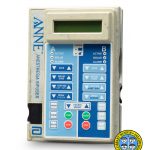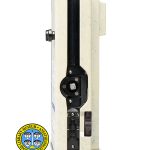Abbott Anne Infusor
Anne Anesthesia Infuser
The first patient-controlled analgesia (PCA) device for delivering intravenous pain medications was introduced in 1968 by New York anesthesiologist Phillip H. Sechzer, M.D. (1914-2004). Within a decade, commercial models had become available. This was an advance over relying upon the patient to ask for pain relief by injections, or for the caregiver to do so based on a schedule. These devices have a setting that prevents the delivery of additional medication before the previous dose has had time to take effect. PCAs give the patient some control in managing his pain, by making the right amount of analgesia available at the right time.
The Anne Anesthesia Infuser, shown here, was made by Abbott Laboratories in the 1990s. This computerized unit could deliver both continuous infusion and on-demand doses. Constant-rate administration addresses continuous postoperative pain. Demand-dosing allows the patient to prepare for, or respond to, acute pain, such as that caused by coughing.
Catalog Record: Abbott Anne Infusor Abbott Anne
Access Key: aqkk
Accession No.: 2001-10-04-1 A
Title: Anne Anesthesia Infusor / Abbott Laboratories.
Corporate Author: Abbott Laboratories.
Title variation: Alt Title
Title: Abbott PCA device.
Title variation: Alt Title
Title: Abbott Anne Anesthesia Infusion System.
Publisher: North Chicago, Illinois : Abbott Laboratories, [between ca. 1992 and 2001].
Physical Description: 1 infusion pump : plastics, metals ; 15 x 11.5 x 6 cm.
Subject: Analgesia, Patient-Controlled – instrumentation.
Subject: Self Administration.
Note Type: General
Notes: The first year in the date range is based on a survey of the available literature. The cataloger found 15 Abbott PCA models in publications dating from 1976 through 2013. Of these, the majority were published in the 1990s, and describe models in the Abbott LifeCare series. The cataloger found publications that mention the cataloged model dated between 1992 and 2010. When received, the object held two 9 volt batteries with the expiration date 1999. The actual date of manufacture is likely to have been somewhat earlier.
The object is described from the perspective of the operator. The control panel is on the front, the instructions are on the back, and the on-off switch is on the bottom.
Note Type: With
Notes: A wire bracket is associated with the cataloged object. Only the pump itself was photographed.
Note Type: Citation
Notes: Abbott Laboratories Company File. Archives. Located at: Wood Library-Museum of Anesthesiology, Schaumburg, Illinois.
Note Type: Citation
Notes: Ehrenwerth J, Eisenkraft JB. Anesthetic Equipment: Principles and Applications. St. Louis: Mosby, 1993.
Note Type: Citation
Notes: Ehrenwerth J, Eisenkraft JB, Berry JM. Anesthetic Equipment: Principles and Applications, 2nd ed. Philadelphia: Elsevier, 2013.
Note Type: Citation
Notes: Ferrante FM, VadeBoncouer TR. Postoperative Pain Management. New York: Churchill Livingstone, 1993:255-268 and 628-633.
Note Type: Citation
Notes: Fragen RJ. Drug Infusions in Anesthesiology. New York: Raven Press, 1991:151-158.
Note Type: Citation
Notes: Graziosi P, et al. Echocardiographic and hemodynamic determinants of right coronary artery flow reserve and phasic flow in advanced non-ischemic cardiomyopathy. Cardiovascular Ultrasound. September 26, 2007;5:31.
Note Type: Citation
Notes: Harmer M, Rosen M, Vickers MD, eds. Patient-controlled Analgesia: Proceedings of the First International Workshop on Patient-Controlled Analgesia, held at Leeds Castle, Kent, United Kingdom, in June, 1984. Oxford: Blackwell Scientific Publications, 1985.
Note Type: Citation
Notes: New York Times website. http://www.nytimes.com/2004/10/04/obituaries/us/philip-h-sechzer-90-expert-on-pain-and-how-to-ease-it.html?_r=0. Accessed May 25, 2017.
Note Type: Citation
Notes: Sechzer PH. Objective Measurement of Pain. Anesthesiology. January-February, 1968;29(1):209-210.
Note Type: Physical Description
Notes: One pump infuser; The object’s housing is made of mottled grey plastic; A control panel occupies most of the front side; To the left of the panel, an adhesive label reads, from top to bottom: “ANNE ™ ANESTHESIA INFUSER”; Below this is a black plastic thumb-switch; Below this switch is another adhesive label that bears the Abbott logo; The control panel is raised approximately 1 centimeter above the rest of the unit; The control panel resembles a hand-held digital calculator in size, shape and layout, with an LCD readout panel at the upper end;
The panel is arranged in two main sections; That section on the left is marked “A”, and has a light blue background; From top to bottom, the elements of section A are: a light marked “ACTIVE”, a light marked “BOLUS”, a light marked “ALARM”, a membrane switch marked “[upward arrow] RATE [downward arrow]”, a membrane switch marked “[upward arrow] BOLUS [downward arrow], a membrane switch marked “[upward arrow] CONT SIZE [downward arrow] [leftward arrow] AMT INF [rightward arrow]”, a membrane switch marked “[upward arrow] DRUG/CONCERN [downward arrow]”, a membrane switch marked “ENTER”, a membrane switch marked “PURGE”, a membrane switch marked “BOLUS”; To the right of the last three buttons are two more marked “START” and “STOP”, respectively;
That section on the right is marked “B”, and has a dark blue background; From top to bottom, the elements of section A are: a light marked “ACTIVE”, a light marked “BOLUS”, a light marked “ALARM”, a membrane switch marked “[upward arrow] RATE [downward arrow]”, a membrane switch marked “[upward arrow] BOLUS [downward arrow], a membrane switch marked “[upward arrow] CONT SIZE [downward arrow] [leftward arrow] AMT INF [rightward arrow]”, a membrane switch marked “[upward arrow] DRUG/CONCERN [downward arrow]”, a membrane switch marked “ENTER”, a membrane switch marked “PURGE”, a membrane switch marked “BOLUS”; To the left of the last three buttons are two more marked “START” and “STOP”, respectively;
Overlapping sections A and B, at the top of the control panel, are two condition lights marked “POWER”; The upper light is marked with a symbol indicating that battery power is being used; The lower light is marked with a symbol indicating that an electrical cord is in use; Overlapping sections A and B, below the switches marked “Drug/Concern”, is a membrane switch marked “[upward arrow] PATIENT WEIGHT [downward arrow”;
The back of the object holds a compartment that can hold two 9 volt batteries; There is a large black screw on either side of this panel; Along the left edge on this side, there is a black thumb switch (identical to that on the front), and an adhesive label; This label reads: “FDA Regulation 21 CFR 821 requires that this [new line] device be tracked when placed in home care [new line] use. The home care distributor must register [new line] this device with Abbott
Laboratories [new line] Phone 1-800-ABBOTT-3 [new line] 735-37010-001″; Another adhesive label occupies most of the lower half of this side; This label reads, in part: “Abbott ANNE ™ [new line] Refer to pump operating manual for further instructions. Only compatible [new line] Abbott Anesthesia Pump Sets can be used with this device […. new line] SET UP […. new line] ALARMS: Press STOP and correct alarm condition […. new line] Serial No. 10700316 [new line] 101456 [new line] E”;
Both the right and the left sides of the object are shaped to hold tubes, and each has metal parts extruding from the body of the unit; Pushing down on each of the black plastic thumb switches described above causes another a piece of the mechanism to jut forward; The bottom of the object holds a jack receptacle, a red plastic on-off switch, and an adhesive label that reads: “RECONDITIONED BY [new line] Abbott Laboratories [new line] North Chicago, Illinois 60064 [new line] 735-38083-002”.
Note Type: Reproduction
Notes: Photographed by Mr. Steve Donisch, June 19, 2017.
Note Type: Historical
Many anesthesiologists specialize in pain medicine. The first patient-controlled analgesia (PCA) device for delivering intravenous pain medications was introduced in 1968 by New York anesthesiologist Phillip H. Sechzer, M.D. (1914-2004). Within a decade, commercial models had become available. This was an advance over relying upon the patient to ask for pain relief by injections, or for the caregiver to do so based on a schedule. These devices have a setting that prevents the delivery of additional medication before the last dose has had time to take effect. PCAs give the patient agency in managing his pain, by making the right amount of analgesia available at the right time.
The Anne Anesthesia Infuser, shown here, was made by Abbott Laboratories in the 1990s. This computerized unit could deliver both continuous infusion and on-demand doses. Constant-rate administration addresses continuous postoperative pain. Demand-dosing allows the patient to prepare for, or respond to acute pain, such as that caused by coughing.
Note Type: Exhibition
Notes: Selected for the WLM website.



